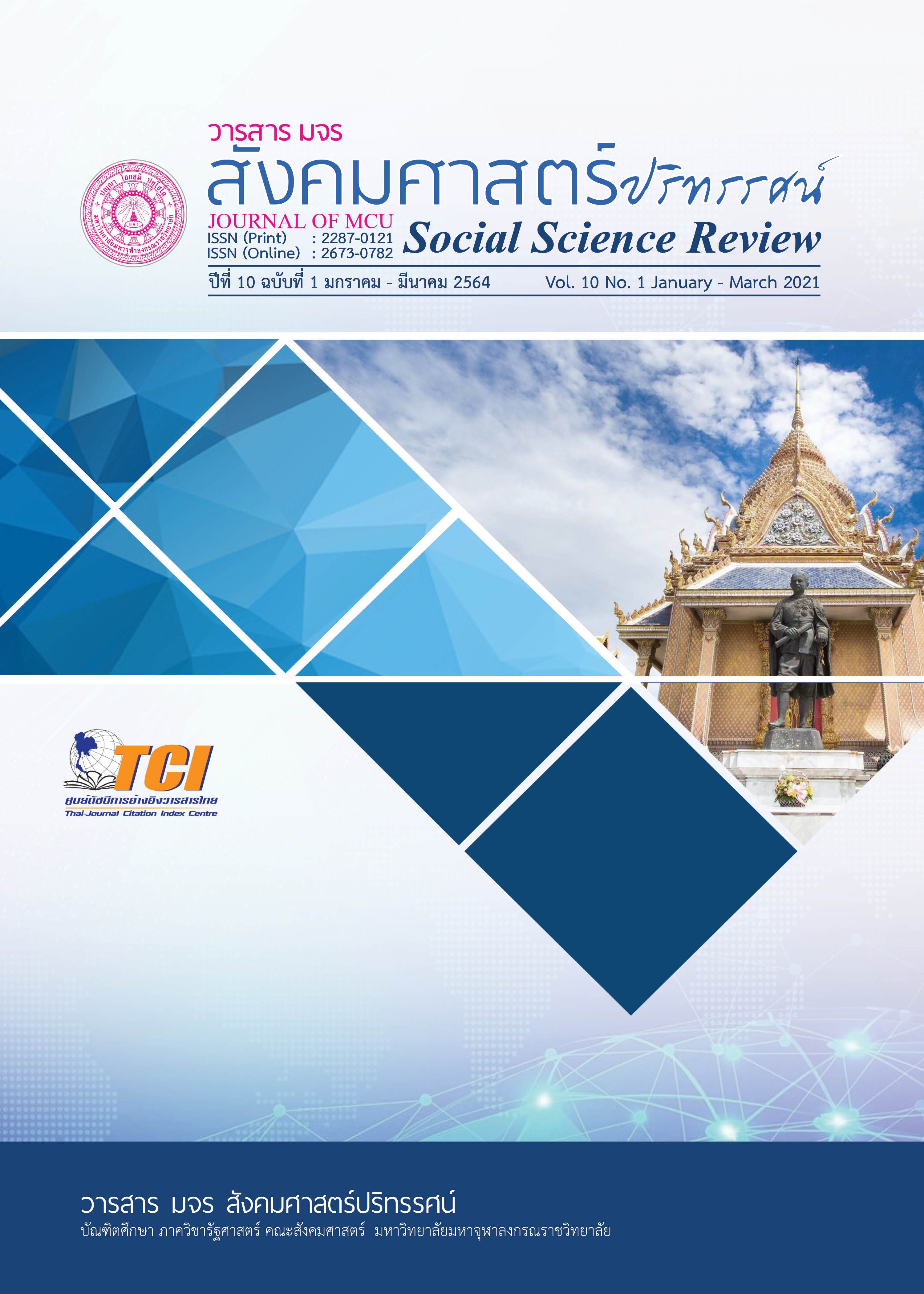THE CONFIRMATORY FACTOR ANALYSIS OF REVERSE LOGISTICS MANAGEMENT OF SME IN THE MANUFACTURING SECTOR
Keywords:
Reverse Logistics Management, Remanufacturing, Waste DisposalAbstract
Objectives of this research were to study the confirmatory factor analysis of reverse logistics management of SME in the manufacturing sector. The research was conducted with mixed methods between the qualitative research by documentary research for literature review on reverse logistics management and quantitative research with a questionnaire used to collect data from 420 SME in the electronics manufacturing sector for confirmatory factor analysis. Findings indicated that reverse logistics management (RLM) had essential to create business sustainability. It focused on the high logistics and operation efficiencies, consisted of 3 dimensions, such as return policy and procedure, remanufacturing or refurbishment, and waste disposal. Also, the result of confirmatory factor analysis indicated that the Chi-Square = .190, Chi-square/df = 190, df = 1, p-value = .663, GFI = 1.000, CFI = 1.000, RMR = .003, RMSEA = .000, SRMR = .0042 that meet the criteria for consideration. RLM can be applied to create a competitive advantage in a sustainability perspective to reduce recourse and protect the company with RLM operation from the non-tariff barrier, such as environmental concern, cost reduction, Image and credibility.
References
Abdullah, N. & Yaakub, S. (2014). Reverse Logistics: Pressure for Adoption and the Impact on Firm’s Performance. International Journal of Business and Society, 15(1), 151-170.
APICs. (2020). Reverse Logistics Management. Retrieved February 8, 2020 from http://www.pasoa.org/201-Presentatopm/Studemt_Presentation.pdf
Bernon et al. (2013). An Exploration of Supply Chain Integration in the Retail Product Returns Process. International Journal of Physical Distribution and Logistics Management, 43(7), 586-608.
Bravo, S. & Carvalho, J. (2013). Understanding Pharmaceutical Sustainable Supply Chains-a Case Study Application. Independent Journal of Management and Production, 4(1), 228-247.
Cojocariu, C. R. (2013). The Reverse Gear of Logistics. Review of International Comparative Management, 14(1), 153-164.
Draskovic, M. (2013). Organization of Outsourcing in Logistics Partnership Between the Seaports of Montenegro and Slovenia. Montenegrin Journal of Economics, 9(1), 93-114.
Fleischmann, M. (2001). Quantitative Models for Reverse Logistics.Berlin: Springer.
Gao, X. (2019). A Novel Reverse Logistics Network Design Considering Multi-Level Investments for Facility Reconstruction with Environmental Considerations. MDPI Sustainability, 11, 18-39.
Hall et al. (2014). Reverse Logistics Information System Success and the Effect of Motivation. International Journal of Physical Distribution and Logistics Management, 44(3), 201-220.
Kuczenski, B. & Geyer, R. (2012). PET Bottle Reverse Logistics-Environmental Performance of California’s CRV Program. International Journal Life Cycle Assess, 18, 456-471.
Kye et al. (2013). The Perceived Impact of Packaging Logistics on The Efficiency of Freight Transportation (EOT). International Journal of Physical Distribution and Logistics Management,43(8), 707-720.
Lee et al. (2012). Designing an Integrated Logistics Network in a Supply Chain System. Journal of Civil Engineering, 17(4), 806-814.
Li, Z., & Huang, J. (2018). How to Effectively Improve Pesticide Waste Governance: a Perspective of Reverse Logistics, MDPI Sustainability, 10, 1-19.
Moghaddam et al. (2018). A Reverse Logistics Chain Mathematical Model for a Sustainable Production System of Perishable Goods Based on Demand Optimization. Journal of Industrial Engineering International, 15, 709-721.
Nagy et al. (2012). The Vehicle Routing Problem with Restricted Mixing of Deliveries and Pickups. New York: Springer.
Panagiotidou et al. (2013). Optimal Procurement and Sampling Decisions Under Stochastic Yield of Returns in Reverse Supply Chains. OR Spectrum, 35, 1-32.
Pellicer, P.C. & Valero, F.A. (2018). Identification of Reverse Logistics Decision Types from Mathematical Models. Journal of Industrial Engineering and Management, 11(2), 239-249.
Rogers, D.S. & Tibben-Lembke, R.S. (1998). Going Backwards: Reverse Logistics Trends and Practices. Nevada: University of Nevada Reno Center for Logistics Management.
Srisorn, W. (2013). The Benefit of Green Logistics to Organization. International Journal of Economics and Management Engineering, 7(8), 2451-2454.
Stock, J.R. (1998). Development and Implementation of Reverse Logistics Programs. Illinois: Council of Logistics Management.
Tepprasit, P. & Yuvanont, P. (2015). The Impact of Logistics Management on Reverse Logistics in Thailand’s Electronics Industry. International Journal of Business and Information, 10(2), 257-275.
Thierry et al. (1995). S=Strategic Issues in Product Recovery Management. California Management Review, 37(2), 114-135.
Tombido et al. (2018). A Systematic Review of 3pls’ Entry into Reverse Logistics. South African Journal of Industrial Engineering, 29(3), 235-260.
Voigt et al. (2019). Performance Evaluation of Reverse Logistics: Opportunities for Future Research. MDPI Sustainability, 11, 1-17.
Wiggins, R, M. (2018). Examination of The Critical Success Factors of a Reverse Logistics Supply Chain (Doctoral Dissertation). Minneapolis: Capella University.
Winter, M. & Knemeyer. M. (2012). Exploring the Integration of Sustainability and Supply Chain Management Current State and Opportunities for Future Inquiry. International Journal of Physical Distribution and Logistics Management, 43(1), 18-38.
Zhang et al. (2013). A Forward and Reverse Logistics Shipment Planning Model. Journal of The Operational Research Society,64(10), 1485-1502.
Downloads
Published
How to Cite
Issue
Section
License
Copyright (c) 2021 Journal of MCU Social Science Review

This work is licensed under a Creative Commons Attribution-NonCommercial-NoDerivatives 4.0 International License.
In order to conform the copyright law, all article authors must sign the consignment agreement to transfer the copyright to the Journal including the finally revised original articles. Besides, the article authors must declare that the articles will be printed in only the Journal of MCU Journal of Social Sciences. If there are pictures, tables or contents that were printed before, the article authors must receive permission from the authors in writing and show the evidence to the editor before the article is printed. If it does not conform to the set criteria, the editor will remove the article from the Journal without any exceptions.





